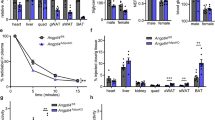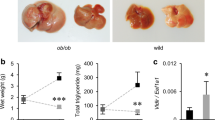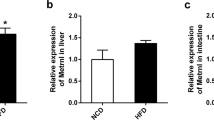Abstract
Objective:
We recently described that hypertriglyceridemic apolipoprotein (apo) CIII transgenic mice show increased whole body metabolic rate. In this study, we used these apo CIII-expressing mice, combined or not with the expression of the natural promoter-driven CETP gene, to test the hypothesis that both proteins modulate diet-induced obesity.
Measurements and results:
Mice expressing apo CIII, CIII/CETP, CETP and nontransgenic (NonTg) mice were maintained on a high-fat diet (14% fat by weight) during 20 weeks after weaning. At the end of this period, all groups exhibited the expected lipemic phenotype. Fasting glucose levels were neither affected by the high-fat diet nor by the distinct genotypes. However, apo CIII mice showed significantly higher glycemia (∼35%) and lower insulin levels (∼45%) in the fed state, compared with the NonTg mice. The apo CIII mice presented significantly increased body weight, lipid content of the carcass (∼25%), visceral adipose tissue mass (about twofold) and adipocyte size (∼25%) compared with the CETP and NonTg mice. The CETP expression in the apo CIII background normalized the subcutaneous adipose depot and visceral adipocyte size to the levels of NonTg mice. Plasma leptin levels were lower in CETP groups (25–50%) and higher in the apo CIII mice. Similar core body temperature in all groups and similar liver mitochondrial resting respiration rates in CIII and NonTg mice indicate no differences in basal energy expenditure rates among these mice fed a high-fat diet.
Conclusion:
The elevation of plasma apo CIII levels aggravates diet-induced obesity and the expression of physiological levels of circulating CETP reverses this adipogenic effect, indicating a novel role for CETP in modulating adiposity.
This is a preview of subscription content, access via your institution
Access options
Subscribe to this journal
Receive 12 print issues and online access
$259.00 per year
only $21.58 per issue
Buy this article
- Purchase on Springer Link
- Instant access to full article PDF
Prices may be subject to local taxes which are calculated during checkout





Similar content being viewed by others
References
Mancini M, Steiner G, Betteridge DJ, Pometta D . Acquired (secondary) forms of hypertriglyceridemia. Am J Cardiol 1991; 68: A17–A21.
Assmann G, Brewer Jr HB . Genetic (primary) forms of hypertriglyceridemia. Am J Cardiol 1991; 68: A13–A16.
Jong MC, Hofker MH, Havekes LM . Role of apoCs in lipoprotein metabolism: functional differences between apoC1, apoC2, and apoC3. Arterioscle Thromb Vas Biol 1999; 19: 472–484.
Jong MC, Rensen PC, Dahlmans VE, Van Der Boom H, Van Berkel TJ, Havekes LM . Apolipoprotein C-III deficiency accelerates triglyceride hydrolysis by lipoprotein lipase in wild-type and apoE knockout mice. J Lipid Res 2001; 42: 1578–1585.
Kashyap ML, Srivasta LS, Hynd BA, Gartside PS, Perisutti G . Quantitation of human apolipoprotein C-III and its subspecies by radioimmunoassay and analytical isoelectric focusing: abnormal plasma triglyceride-rich lipoprotein apolipoprotein C-III subspecie concentrations in hypertriglyceridemia. J Lipid Res 1981; 22: 800–810.
Fredenrich A, Giroux LM, Tremblay M, Krimbou L, Davignon J, Cohn JS . Plasma lipoprotein distribution of apoC-III in normolipidemic and hypertriglyceridemic subjects: comparison of the apoCIII to apoE ratio in different lipoprotein fractions. J Lipid Res 1997; 38: 1421–1432.
Ito Y, Azrolan N, O’connell A, Walsh A, Breslow JL . Hypertriglyceridemia as a result of human apolipoprotein C-III gene expression in transgenic mice. Science 1990; 249: 790–793.
Aalto-Setala K, Fisher EA, Chen X, Chajekshaul T, Hayek T, Zechner R et al. Mechanism of hypertriglyceridemia in human apolipoprotein (apo) C-III transgenic mice: diminished very low density lipoprotein fractional catabolic rate associated with increased apoCIII and reduced apoE on the particles. J Clin Invest 1992; 90: 1889–1900.
De Silva HV, Lauer SJ, Wang J, Simonett WS, Weisgraber KH, Mahley RW et al. Overexpression of human apolipoprotein C-III in transgenic mice results in accumulation of apolipoprotein B48 remnant that is corrected by excess apolipoprotein E. J Biol Chem 1994; 269: 2324–2335.
Forte TM, Nichols AV, Krauss RM, Norum RA . Familial apolipoprotein AI and apolipoprotein CIII deficiency. Subclass distribution, composition, and morphology of lipoproteins in a disorder associated with premature atherosclerosis. J Clin Invest 1984; 74: 1601–1613.
Von Eckardstein A, Holz H, Sandkamp M, Weng W, Funke H, Assmann G . Apolipoprotein C-III(Lys58- - - -Glu). Identification of an apolipoprotein C-III variant in a family with hyperalphalipoproteinemia. J Clin Invest 1991; 87: 1724–1731.
Maeda N, Li H, Lee D, Oliver P, Quarfordt SH, Osada J . Targeted disruption of the apolipoprotein C-III gene in mice results in hypotriglyceridemia and protection from postprandial hypertriglyceridemia. J Biol Chem 1994; 269: 10–16.
Ebara T, Ramakrishnan R, Steiner G, Shachter NS . Chylomicronemia due to apolipoprotein C-III overexpression in apolipoprotein E-null mice: apolipoprotein C-III-induced hypertriglyceridemia is not mediated by effects on apoE. J Clin Invest 1997; 99: 2672–2681.
Kowal RC, Herz J, Weisgraber KH, Mahley RW, Brown MS, Goldstein JL . Opposing effects of apolipoprotein E and C on lipoprotein binding to low density lipoprotein receptor-related protein. J Biol Chem 1990; 265: 10771–10779.
Sehayek E, Eisenberg S . Mechanisms of inhibition by apolipoprotein C of apolipoprotein E-dependent cellular metabolism of human triglyceride-rich lipoproteins through the low-density lipoprotein receptor pathway. J Biol Chem 1991; 266: 18259–18267.
Aalto-Setala K, Weinstock PH, Bisgaier CL, Wu L, Smith JD, Breslow JL . Further characterization of the metabolic properties of triglyceride-rich lipoproteins from human and mouse apoC-III transgenic mice. J Lipid Res 1996; 37: 1802–1811.
Tall AR . Plasma cholesteryl ester transfer protein. J Lipid Res 1993; 34: 1255–1274.
Ha YC, Barter PJ . Differences in plasma cholesteryl ester transfer activity in sixteen vertebrate species. Comp Biochem Physiol B 1982; 71: 265–269.
Jiang X, Moulin P, Quinet E, Goldberg IJ, Yacoub LK, Agellon LB et al. Mammalian adipose tissue and muscle are major sources of lipid transfer protein mRNA. J Biol Chem 1991; 266: 4631–4639.
Agellon LB, Walsh A, Hayek T, Moulin P, Jiang XC, Shelanski SA et al. Reduced high density lipoprotein cholesterol in human cholesteryl ester transfer protein transgenic mice. J Biol Chem 1991; 266: 10796–10801.
Jiang XC, Agellon LB, Walsh A, Breslow JL, Tall AR . Dietary cholesterol increases transcription of the human cholesteryl ester transfer protein gene in transgenic mice. Dependence on natural flanking sequences. J Clin Invest 1992; 90: 1290–1295.
Marotti KR, Castle CK, Boyle TP, Lin AH, Murray RW, Melchior GW . Severe atherosclerosis in transgenic mice expressing simian cholesteryl ester transfer protein. Nature 1993; 364: 73–75.
Plump AS, Masucci-Magoulas L, Bruce C, Bisgaier CL, Breslow JL, Tall AR . Increased atherosclerosis in ApoE and LDL receptor gene knock-out mice as a result of human cholesteryl ester transfer protein transgene expression. Arterioscler Thromb Vasc Biol 1999; 19: 1105–1110.
Harada LM, Amigo L, Cazita PM, Salerno AG, Rigotti AA, Quintão EC et al. CETP expression enhances liver HDL-cholesteryl ester uptake but does not alter VLDL and biliary lipid secretion. Atherosclerosis 2007; 191: 313–318.
Vassiliou G, Mcpherson R . Role of cholesteryl ester transfer protein in selective uptake of high-density lipoprotein cholesteryl esters by adipocytes. J Lipid Res 2004; 45: 1683–1693.
Gauthier A, Lau P, Zha X, Milne R, Mcpherson R . Cholesteryl ester transfer protein directly mediates selective uptake of high-density lipoprotein cholesteryl esters by the liver. Arterioscler Thromb Vasc Biol 2005; 25: 2177–2184.
Hayek T, Masucci-Magoulas L, Jiang X, Walsh A, Rubin E, Breslow JL et al. Decreased early atherosclerotic lesions in hypertriglyceridemic mice expressing cholesteryl ester transfer protein transgene. J Clin Invest 1995; 96: 2071–2074.
Cazita PM, Berti JA, Aoki C, Gidlund M, Harada LM, Nunes VS et al. Cholesteryl ester transfer protein expression attenuates atherosclerosis in ovariectomized mice. J Lipid Res 2003; 44: 33–40.
Casquero AC, Berti JA, Salerno AG, Bighetti EJ, Cazita PM, Ketelhth DF et al. Atherosclerosis is enhanced by testosterone deficiency and attenuated by CETP expression in transgenic mice. J Lipid Res 2006; 47: 1526–1534.
Clark RW . Raising high-density lipoprotein with cholesteryl ester transfer protein inhibitors. Curr Opin Pharmacol 2006; 6: 162–168.
Pearson H . When good cholesterol turns bad. Nature 2006; 444: 794–795.
Tall AR, Yvan-Charvet L, Wang N . The failure of torcetrapib: was it the molecule or the mechanism? Arterioscler Thromb Vasc Biol 2007; 27: 257–260.
Zhou H, Li Z, Hojjati MR, Jang D, Beyer TP, Cao G et al. Adipose tissue specific CETP expression in mice: impact on lipoprotein metabolism. J Lipid Res 2006; 47: 2011–2019.
Alberici LC, Oliveira HCF, Patrício PR, Kowaltowski AJ, Vercesi AE . Hyperlipidemic mice present enhanced catabolism and higher mitochondrial ATP-sensitive K+ channel activity. Gastroenterology 2006; 131: 1228–1234.
Duivenvoorden I, Teusink B, Rensen PC, Romijn JA, Havekes LM, Voshol PJ . Apolipoprotein C3 deficiency results in diet-induced obesity and aggravated insulin resistance in mice. Diabetes 2005; 54: 664–671.
Jong MC, Voshol PJ, Muurling M, Dahlmans VE, Romijn JA, Pijl H et al. Protection from obesity and insulin resistance in mice overexpressing human apolipoprotein C1. Diabetes 2001; 50: 2779–2785.
Walsh A, Azrolan N, Wang K, Marcigliano A, O’connell A, Breslow JL . Intestinal expression of the human apoA-I gene in transgenic mice is controlled by a DNA region 3’ to the gene in the promoter of the adjacent convergently transcribed apoC-III gene. J Lipid Res 1993; 34: 617–623.
Berti JA, Amaral ME, Boschero AC, Nunes VS, Harada LM, Castilho LN et al. Thyroid hormone increases plasma cholesteryl ester transfer protein activity and plasma high-density lipoprotein removal rate in transgenic mice. Metabolism 2001; 50: 530–536.
Scott AM, Atwater I, Rojas E . A method for the simultaneous measurement of insulin release and B cell membrane potential in single mouse islets of Langerhans. Diabetologia 1981; 21: 470–475.
Rodbell M . Metabolism of isolated fat cells. Effects of hormones on glucose metabolism and lipolysis. J Biol Chem 1964; 239: 375–380.
Kaplan RS, Pedersen PL . Characterization of phosphate efflux pathways in rat liver mitochondria. Biochem J 1983; 212: 279–288.
Boschero AC, Szpak-Glasman M, Carneiro EM, Bordin S, Paul I, Rojas E et al. Oxotremorine-m potentiation of glucose-induced insulin release from rat islets involves M3 muscarinic receptors. Am J Physiol 1995; 268: E336–E342.
Van Harmelen V, Dicker A, Rydén M, Hauner H, Lonnqvist F, Naslund E et al. Increased lipolysis and decreased leptin production by human omental as compared with subcutaneos preadipocytes. Diabetes 2002; 51: 2029–2036.
Amaral ME, Oliveira HCF, Carneiro EM, Delghingaro-Augusto V, Vieira EC, Berti JA et al. Plasma glucose regulation and insulin secretion in hypertriglyceridemic mice. Horm Metab Res 2002; 34: 21–26.
Reaven GM, Mondon CE, Chen YD, Breslow JL . Hypertriglyceridemic mice transgenic for the human apolipoprotein C-III gene are neither insulin resistant nor hyperinsulinemic. J Lipid Res 1994; 35: 820–824.
Biddinger SB, Kahn CR . From mice to men: insights into the insulin resistance syndromes. Annu Rev Physiol 2006; 68: 123–158.
Yin W, Liao D, Kusunoki M, Xi S, Tsutsumi K, Wang Z et al. NO-1886 decreases ectopic lipid deposition and protects pancreatic beta cells in diet-induced diabetic swine. J Endocrinol 2004; 180: 399–408.
Araujo EP, De Souza CT, Gasparetti AL, Ueno M, Boschero AC, Saad MJ et al. Short-term in vivo inhibition of insulin receptor substrate-1 expression leads to insulin resistance, hyperinsulinemia, and increased adiposity. Endocrinology 2005; 146: 1428–1437.
Conde-Knape K, Okada K, Ramakrishnan R, Shachter NS . Overexpression of apoC-III produces lesser hypertriglyceridemia in apoB-48-only gene-targeted mice than in apoB-100-only mice. J Lipid Res 2004; 45: 2235–2244.
Le Lay S, Krief S, Farnier C, Lefrere I, Le Liepvre X, Bazin R et al. Cholesterol, a cell size-dependent signal that regulates glucose metabolism and gene expression in adipocytes. J Biol Chem 2001; 276: 16904–16910.
Asayama K, Hayashibe H, Dobashi K, Uchida N, Nakane T, Kodera K et al. Increased serum cholesteryl ester transfer protein in obese children. Obes Res 2002; 10: 439–446.
Arai T, Yamashita S, Hirano K, Sakai N, Kotani K, Fujioka S et al. Increased plasma cholesteryl ester transfer protein in obese subjects. A possible mechanism for the reduction of serum HDL cholesterol levels in obesity. Arterioscler Thromb 1994; 14: 1129–1136.
Teran-Garcia M, Despres JP, Tremblay A, Bouchard C . Effects of cholesterol ester transfer protein (CETP) gene on adiposity in response to long-term overfeeding. Atherosclerosis 2006 [ahead of print, DOI: 10.1016/j.atherosclerosis.2006.12.005].
Boekholdt SM, Thompson JF . Natural genetic variation as a tool in understanding the role of CETP in lipid levels and disease. J Lipid Res 2003; 44: 1080–1093.
Acknowledgements
This study is part of the PhD thesis of AG Salerno and was supported by grants from Fundação de Amparo à Pesquisa do Estado de São Paulo (FAPESP) and Conselho Nacional para o Desenvolvimento Científico e Tecnológico (CNPq). We are grateful to Lécio D Teixeira for animal caring.
Author information
Authors and Affiliations
Corresponding author
Rights and permissions
About this article
Cite this article
Salerno, A., Silva, T., Amaral, M. et al. Overexpression of apolipoprotein CIII increases and CETP reverses diet-induced obesity in transgenic mice. Int J Obes 31, 1586–1595 (2007). https://doi.org/10.1038/sj.ijo.0803646
Received:
Revised:
Accepted:
Published:
Issue Date:
DOI: https://doi.org/10.1038/sj.ijo.0803646
Keywords
This article is cited by
-
Pubertal glyphosate-based herbicide exposure aggravates high-fat diet-induced obesity in female mice
Environmental Science and Pollution Research (2024)
-
VLDL and apolipoprotein CIII induce ER stress and inflammation and attenuate insulin signalling via Toll-like receptor 2 in mouse skeletal muscle cells
Diabetologia (2017)
-
Cholesteryl Ester Transfer Protein (CETP) expression does not affect glucose homeostasis and insulin secretion: studies in human CETP transgenic mice
Lipids in Health and Disease (2016)
-
Apolipoprotein CIII overexpression exacerbates diet-induced obesity due to adipose tissue higher exogenous lipid uptake and retention and lower lipolysis rates
Nutrition & Metabolism (2015)
-
Liver proteomic response to hypertriglyceridemia in human-apolipoprotein C-III transgenic mice at cellular and mitochondrial compartment levels
Lipids in Health and Disease (2014)



